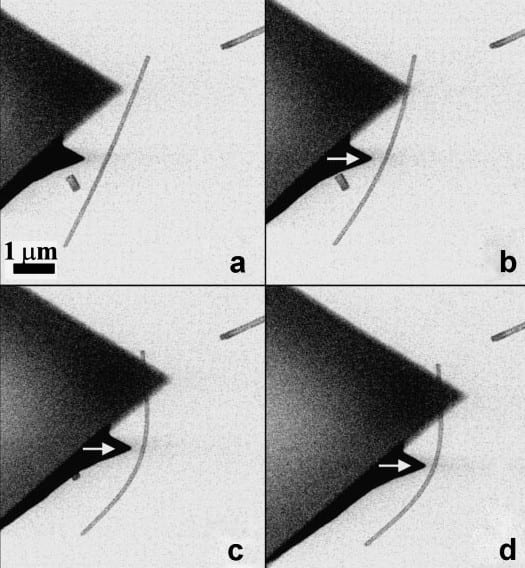Welcome to the latest selection of recent top articles in the physica status solidi journals. Get a glimpse of our publication spectrum and visit our pages by clicking on any of the DOI links below.
Topological insulator nanostructures [Review@RRL]
Judy J. Cha, Kristie J. Koski, and Yi Cui
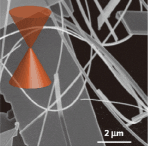 Nanostructured topological insulators with large surface-to-volume ratios are essential in order to study and control the exotic electronic properties of the topological surface states. Following the discovery of binary chalcogenides as topological insulators, the progress in the topological insulator research field has been remarkable. In this Review@RRL, synthesis of topological insulator nanostructures, notable transport experiments, and current nanomaterial challenges together with the corresponding solutions are presented for general readers.
Nanostructured topological insulators with large surface-to-volume ratios are essential in order to study and control the exotic electronic properties of the topological surface states. Following the discovery of binary chalcogenides as topological insulators, the progress in the topological insulator research field has been remarkable. In this Review@RRL, synthesis of topological insulator nanostructures, notable transport experiments, and current nanomaterial challenges together with the corresponding solutions are presented for general readers.
Phys. Status Solidi RRL (2012) DOI 10.1002/pssr.201206393
Topological phase transition in bulk materials described by the coherent potential approximation technique [Review@RRL]
Stanislav Chadov, Janos Kiss, Jürgen Kübler, and Claudia Felser
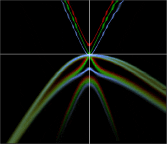 The coherent potential approximation (CPA) widely used to model random chemical disorder can also be applied as an efficient adiabatic technique to study the topological state of the material from first principles. As Chadov et al. show here, by emulating the transition between topologically-distinct phases via CPA, one always encounters an intermediate composition which exhibits a Dirac cone in the bulk.
The coherent potential approximation (CPA) widely used to model random chemical disorder can also be applied as an efficient adiabatic technique to study the topological state of the material from first principles. As Chadov et al. show here, by emulating the transition between topologically-distinct phases via CPA, one always encounters an intermediate composition which exhibits a Dirac cone in the bulk.
Phys. Status Solidi RRL (2012) DOI 10.1002/pssr.201206395
Recent progress in the understanding of exciton dynamics within phosphorescent OLEDs [Feature Article]
Sebastian Reineke and Marc A. Baldo
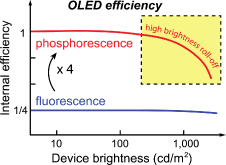 The use of phosphorescent emitter molecules in organic light-emitting diodes (OLEDs) allows that every exciton formed in the organic emission layer(s) can emit a photon. With that, phosphorescence provides a fourfold improvement over conventional fluorescent OLEDs to unity internal quantum efficiency. In turn, the excited state lifetimes of the triplet emitters used are orders of magnitude longer than the ones of singlet excitons introducing a noticeable efficiency roll-off. In this Feature Article, Reineke and Baldo review recent progress in the understanding of phosphorescence in OLEDs. In addition, the authors discuss emerging conceptual alternatives to phosphorescence like extrafluorescence and thermally delayed fluorescence.
The use of phosphorescent emitter molecules in organic light-emitting diodes (OLEDs) allows that every exciton formed in the organic emission layer(s) can emit a photon. With that, phosphorescence provides a fourfold improvement over conventional fluorescent OLEDs to unity internal quantum efficiency. In turn, the excited state lifetimes of the triplet emitters used are orders of magnitude longer than the ones of singlet excitons introducing a noticeable efficiency roll-off. In this Feature Article, Reineke and Baldo review recent progress in the understanding of phosphorescence in OLEDs. In addition, the authors discuss emerging conceptual alternatives to phosphorescence like extrafluorescence and thermally delayed fluorescence.
Phys. Status Solidi A (2012) DOI 10.1002/pssa.201228292
Interaction between Al–Si melt and dielectric layers during formation of local Al-alloyed contacts for rear-passivated Si solar cells [Original Paper]
A. Uruena, J. Horzel, J. John, E. Cornagliotti, P. Eyben, M. Pfeiffer, W. Vandervorst, J. Poortmans, and R. Mertens
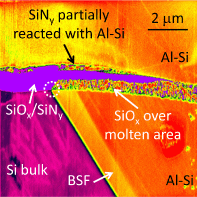 The alloy formation between physical vapor deposited Al and Si at the rear side of the industrially applicable passivated emitter and rear solar cells has been investigated. New insights of sequential phases and phenomena like escape of gaseous bubbles from the melt and reduced surface wetting as a function of the applied temperature profile are documented and a cross-sectional analysis of the local contact formation is performed. It was found that the SiOx layer reacts with the Al–Si melt and that SiNy layer plays a fundamental role for the correct isolation of the solar cells.
The alloy formation between physical vapor deposited Al and Si at the rear side of the industrially applicable passivated emitter and rear solar cells has been investigated. New insights of sequential phases and phenomena like escape of gaseous bubbles from the melt and reduced surface wetting as a function of the applied temperature profile are documented and a cross-sectional analysis of the local contact formation is performed. It was found that the SiOx layer reacts with the Al–Si melt and that SiNy layer plays a fundamental role for the correct isolation of the solar cells.
Phys. Status Solidi A (2012) DOI 10.1002/pssa.201228353
Structural stratification of Sr1–xCaxRuO3 thin films: influence of aging process [Original Paper]
M. Młynarczyk, K. Szot, U. Poppe, U. Breuer, Shaobo Mi, B. Psiuk, E. A. Görlich, K. Tomala, and R. Waser
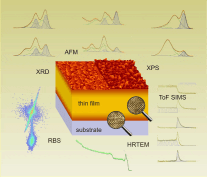 Ruthenates present an attractive field of investigation both due to their physical properties (electric conductivity, superconductivity, magnetism – often unconventional) and their possible technical applications. The heterogeneous in-depth profile of the thin films is extremely important in the fabrication of nanodevices, especially those based on ultra-thin layers. Młynarczyk et al. systematically investigate the structural features of epitaxial Sr1–xCaxRuO3 thin films grown on SrTiO3 and LaAlO3 substrates using high-pressure dc-sputtering. The series of samples were characterized with a number of complementary methods.
Ruthenates present an attractive field of investigation both due to their physical properties (electric conductivity, superconductivity, magnetism – often unconventional) and their possible technical applications. The heterogeneous in-depth profile of the thin films is extremely important in the fabrication of nanodevices, especially those based on ultra-thin layers. Młynarczyk et al. systematically investigate the structural features of epitaxial Sr1–xCaxRuO3 thin films grown on SrTiO3 and LaAlO3 substrates using high-pressure dc-sputtering. The series of samples were characterized with a number of complementary methods.
Phys. Status Solidi A (2012) DOI 10.1002/pssa.201228217
Real-time manipulation of ZnO nanowires on a flat surface employed for tribological measurements: experimental methods and modeling [Original Paper]
L. M. Dorogin, S. Vlassov, B. Polyakov, M. Antsov, R. Lõhmus, I. Kink, and A. E. Romanov
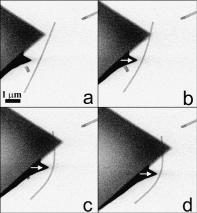 Elastic and tribological properties of ZnO nanowires on Si wafer and highly oriented pyrolytic graphite (HOPG) are experimentally investigated and theoretically interpreted. Measurements are performed inside a scanning electron microscope (SEM) using real-time manipulation technique that enables two possible ways of data registration: “external” force registration with quartz tuning fork based sensor and “internal” force registration utilizing in situ observed elastic deformation of nanowires. It is possible to describe the complete range of tribological phenomena: static friction upon the transition to kinetic friction, pure kinetic friction and the relaxation of kinetic friction to self-balanced static friction.
Elastic and tribological properties of ZnO nanowires on Si wafer and highly oriented pyrolytic graphite (HOPG) are experimentally investigated and theoretically interpreted. Measurements are performed inside a scanning electron microscope (SEM) using real-time manipulation technique that enables two possible ways of data registration: “external” force registration with quartz tuning fork based sensor and “internal” force registration utilizing in situ observed elastic deformation of nanowires. It is possible to describe the complete range of tribological phenomena: static friction upon the transition to kinetic friction, pure kinetic friction and the relaxation of kinetic friction to self-balanced static friction.
Phys. Status Solidi B (2012) DOI 10.1002/pssb.201248445

